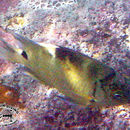Diagnostic Description
provided by Fishbase
Description: Head and body white, vertical bars six grey broad (Ref. 90102). Prominent black spot (saddle) on upper caudal peduncle (Ref. 1602).
Life Cycle
provided by Fishbase
Oviparous, distinct pairing during breeding (Ref. 205). Eggs are demersal and adhere to the substrate (Ref. 205). Males guard and aerate the eggs (Ref. 205).
Morphology
provided by Fishbase
Dorsal spines (total): 13; Dorsal soft rays (total): 14 - 16; Analspines: 2; Analsoft rays: 14 - 15
Trophic Strategy
provided by Fishbase
Occur in small groups or may be solitary. Juveniles usually found in tide pools. Primarily a grazer with regards to their herbivorous habits (Ref. 275). Feed on plants and benthic invertebrates (Ref. 13550).
Biology
provided by Fishbase
Inhabit rocky lagoons, reef flat shorelines and piers subject to mild surge; juveniles are common in tide pools (Ref. 9710). Benthopelagic (Ref. 58302). Occasionally form schools. Feed on algae, crustaceans and other invertebrates during the day. Oviparous, distinct pairing during breeding (Ref. 205). Eggs are demersal and adhere to the substrate (Ref. 205). Males guard and aerate the eggs (Ref. 205). Highly territorial (Ref. 9710). Utilized as a food fish by the Hawaiians (Ref. 7364).
- Recorder
- Estelita Emily Capuli
Importance
provided by Fishbase
fisheries: minor commercial; aquarium: commercial; price category: unknown; price reliability:
- Recorder
- Estelita Emily Capuli
分布
provided by The Fish Database of Taiwan
廣泛分布於印度-太平洋區,自紅海、東非洲至夏威夷群島,北至日本南部,南至澳洲。台灣各地海域及離島之岩礁或珊湖礁海岸均有分布。
利用
provided by The Fish Database of Taiwan
中小型之雀鯛,可食用,一般不為漁獲對象魚。有人將其作觀賞魚之用。
描述
provided by The Fish Database of Taiwan
體呈卵圓形而側扁。吻短而略尖。眼中大,上側位。口小,上頜骨末端不及眼前緣;齒單列,齒端具缺刻。眶下骨裸出,後緣則平滑;前鰓蓋骨後緣亦平滑。體被大櫛鱗;側線之有孔鱗片18-20個。背鰭單一,軟條部延長而呈尖形,硬棘XIII,軟條14-16;臀鰭硬棘II,軟條13-16;胸鰭鰭條18-20;尾鰭叉形,末端呈尖形,上下葉外側鰭條不延長呈絲狀。體呈灰白至淡黃色,體側有6-7條暗灰色橫帶,有時不顯;尾柄之背側另具一大黑圓斑。胸鰭基底上方有一小黑斑;鰓蓋骨後緣上方無黑點。尾鰭淡黃褐色。
棲地
provided by The Fish Database of Taiwan
主要棲息於沿岸淺水岩礁岸之浪拂區,棲息深度在3公尺內,甚少棲息於離岸5公尺以上之水域;其幼魚常出現於潮池中。主要以藻類為食。
Abudefduf sordidus
provided by wikipedia EN
Abudefduf sordidus, commonly known as the blackspot sergeant or kūpīpī in Hawaii, is a large solitary damselfish in the family Pomacentridae native to the tropical Indo-Pacific.[1][2][3][4]
Description
Blackspot sergeants are generally yellowish-grey in colour with six brown broad bars, six to seven narrow light bars and a black spot at the upper base of the tail.[2] They can reach up to 24 cm (9.4 inches) in total length[4] and are known to live up to nine years in the wild.[2]
Habitat and behavior
Blackspot sergeants are common in tidepools and rocky shallow areas with moderate surge at a depth of 0 to 3 m (0 to 10 ft).[2][5][6] Juvenile blackspot sergeants are common in tidepools where they feed on algae, small animals, and plankton.[6] Once they mature and become bigger, they are known to move towards deeper areas with more surge.[6] Blackspot sergeants are very territorially aggressive, especially towards other fish in tidepools.[6][3] During the day they are often found near rocky areas, although at night they tend to take shelter under various objects.[6] Blackspot sergeants are oviparous and males build a nest site in rocky areas to attract females.[6][2] During this mating period they are believed to be especially aggressive.[2]
References

- license
- cc-by-sa-3.0
- copyright
- Wikipedia authors and editors
Abudefduf sordidus: Brief Summary
provided by wikipedia EN
Abudefduf sordidus, commonly known as the blackspot sergeant or kūpīpī in Hawaii, is a large solitary damselfish in the family Pomacentridae native to the tropical Indo-Pacific.
- license
- cc-by-sa-3.0
- copyright
- Wikipedia authors and editors
Description
provided by World Register of Marine Species
Inhabits rocky lagoons, reef flat shorelines and piers subject to mild surge; juveniles are common in tidepools. Occasionally forms schools. Feeds on algae, crustaceans and other invertebrates during the day. Used for food by the Hawaiians (Ref. 7364).
Froese, R. & D. Pauly (Editors). (2023). FishBase. World Wide Web electronic publication. version (02/2023).
- license
- cc-by-4.0
- copyright
- WoRMS Editorial Board

